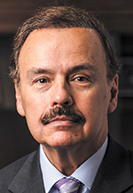Subscriber Benefit
As a subscriber you can listen to articles at work, in the car, or while you work out. Subscribe Now“Can I go home now?”
Those were the words uttered by Andrew Royer, an Elkhart man who had just confessed to strangling 94-year-old Helen Sailor to death. It’s an odd response for someone who’d just admitted to murder, but those who know Royer say his unusual reaction to his confession underscores the fatal flaws in the case against him and points to possible systemic failures in the Elkhart County justice system.
Royer has been diagnosed with schizoaffective disorder, depression and a personality disorder, and his parents have told media outlets their adult son has the mental capacity of a 10-year-old. According to Royer’s defense team, the Elkhart Police Department exploited his disabilities to coerce his confession.
 Gurulé
Gurulé“In terms of understanding the consequences of what he had just told the police, he told you what you wanted to hear,” Notre Dame law professor Jimmy Gurulé said.
Gurulé and a group of Notre Dame Law students have joined with The Exoneration Project at the University of Chicago Law School and the Indiana University Robert H. McKinney School of Law to secure Royer’s release. Led by Chicago attorney Elliot Slosar, the group is continuing a 13-year legal battle to prove what they view as the failures within the justice system that have kept Royer wrongfully in prison for more than a decade.
A gag order imposed by Elkhart Superior Judge Teresa Cataldo prevented Slosar from discussing Royer’s case on the record, but attorneys who have previously worked on the case pointed to recanted witness statements, flawed physical evidence and doubts about Royer’s guilt within the police department as proof that the wrong man is being punished. Elkhart Police Chief Ed Windbigler and Elkhart County Prosecutor Vicki Becker, who is prosecuting Royer’s case, declined to comment for this story.
 Royer’s past attempts at appellate relief have failed, but his former attorneys say now, with Slosar’s resources through the Exoneration Project, Royer likely has a better chance of having his conviction overturned, or of at least getting another hearing before an appellate court. But recent court filings indicate prosecutors are challenging the defense’s alleged “newly discovered evidence” and are standing behind Royer’s conviction.
Royer’s past attempts at appellate relief have failed, but his former attorneys say now, with Slosar’s resources through the Exoneration Project, Royer likely has a better chance of having his conviction overturned, or of at least getting another hearing before an appellate court. But recent court filings indicate prosecutors are challenging the defense’s alleged “newly discovered evidence” and are standing behind Royer’s conviction.
The evidence
Sailor was found dead in her Elkhart apartment on Black Friday in 2002. Royer and his co-defendant, Lana Canen, were implicated in 2003 after Canen’s friend Nina Porter gave a statement to police.
In her statement, Porter told law enforcement Canen told her she had asked Sailor for money, but Sailor refused. Porter said she then heard Canen mumble, “Thanksgiving, thanks for giving death.” Porter also told officers Canen had total control over Royer’s actions, and Elkhart police officers obtained two audio-recorded confessions from Royer, which he gave after hours of unrecorded interrogation.
The key piece of evidence at the ensuing trial was a latent fingerprint found in Sailor’s apartment. Detective Dennis Chapman claimed to be a latent fingerprint expert and testified the print matched Canen’s. That evidence, coupled with statements from Porter and Jerome Johnson — Sailor’s neighbor who claimed the defendants stopped by his apartment on the night of the murder — secured their convictions in 2005.
Royer immediately appealed, unsuccessfully challenging his conviction and the denial denial of his post-conviction relief petition. He attacked the sufficiency of the evidence, the reliability of his confession and the effectiveness of his counsel before the Indiana Court of Appeals. He would later repeat the ineffective assistance of counsel claim in the Indiana Southern District Court, where he was denied habeas relief.
An opportunity arises
Then in 2012, Canen was exonerated with the assistance of Cara Wieneke, an Indianapolis private criminal defense attorney. Wieneke began representing Canen when the public defender agency had a conflict with her case, and she began an investigation that included a retesting of the fingerprint. Wieneke’s fingerprint expert determined the print found in Sailor’s apartment was not a match to Canen, and Chapman called Wieneke and said he “realized he had made a mistake.”
“He didn’t say he lied,” Wieneke said. “But he bragged a little, stretched his experience.”
 Sutherlin
SutherlinOnce Canen was released in 2012, Royer’s team saw an opening to pursue his own exoneration. There was no physical evidence against him, Wieneke said, so the state’s theory was that he killed Sailor under Canen’s direction.
Enter Michael Sutherlin, an Indianapolis attorney who began representing Royer at the successive PCR stage. Sutherlin’s PCR argument drew on the fact that without physical evidence linking Canen to the crime, there was little, if any, evidence to implicate Royer.
But a COA panel declined to authorize Royer to file his successive PCR petition in January 2017. The issue, Sutherlin said, is that Chapman’s misleading statements about his credentials could have been, but were not, challenged on cross-examination.
“It just wasn’t enough, the fingerprint alone,” Wieneke said.
Another chance?
Slosar and the Exoneration Project learned of Royer’s case after the failed successive PCR petition, and their work led to the filing of a petition to vacate judgment in June 2018. The 105-page document details newly discovered evidence that Slosar, acting as pro hac vice, said proves why Royer should be exonerated.
The petition makes much of Royer’s allegedly coerced statement, notably alleging for the first time that Royer’s interrogation was video-recorded. But those recordings were withheld from the defense, the petition says, a violation of Brady v. Maryland, 373 U.S. 83 (1963).
Further, Slosar claims Lt. Peggy Snider signed an affidavit in February 2018 stating her belief that Royer is innocent. But in a response to the petition, the state said Snider was prepared to testify the signature on the affidavit is not hers.
Finally, the petition alleges both Porter and Johnson have recanted their testimonies, which they allegedly say are the result of police coercion. The state, however, maintained there was no evidence to support the defense’s new allegations while also arguing Royer’s claims should be brought pursuant to a second successive PCR petition.
To that end, Slosar moved to withdraw the petition to vacate judgment in favor of filing a second successive PCR petition. As of IL deadline, the PCR petition was not listed in online appellate court records.
Sticking point
Despite the lack of physical evidence against Royer, Wieneke said there is one major hurdle keeping him from going free: his confession. According to Richard Leo, an expert on police interrogation and false confessions and a professor of law and psychology at the University of San Francisco, between 75 and 90 percent of false confession cases that go to trial result in a conviction.
Leo worked on Royer’s case at the PCR level in 2011 and told Indiana Lawyer he remembers seeing several “red flags” in his confession. According to the petition to vacate judgment, “Leo identified several areas where … Royer’s confession did not fit with the known facts of the crime scene.”
Though Leo did not say for certain whether Royer’s confession was coerced, he said there are several techniques police use to obtain a confession, even from an innocent person. Juveniles and people with low IQs are particularly susceptible to such techniques, Leo said, noting people with low IQs may agree with law enforcement’s theory of a crime to avoid appearing “dumb.”
Based on Royer’s mental disabilities, both Sutherlin and Wieneke said they do not believe his confession was voluntary. However, they also acknowledge the very fact that a confession exists does not bode well for him.
“People not in the legal profession think, ‘How can somebody be persuaded to say they did something they never did?’” Sutherlin said. Leo agreed, noting it’s rare for convictions to be overturned based on false confessions alone.
Deeper issues
Earlier in Royer’s appellate process, Wieneke said she told Sutherlin she thought his best chance at exonerating Royer would be to find evidence pointing to another killer. Slosar’s petition includes such evidence, naming two possible suspects: Larry Wood and Tony Thomas.
Both men were at the apartment complex on the day of the murder, and the petition alleges Wood also confessed to strangling Sailor. But this alleged evidence wasn’t presented at trial, a fact Sutherlin said indicates ineffective assistance of counsel, and the petition says proves Elkhart police failed to properly investigate the case.
That alleged failure represents a prominent undertone running through Royer’s most recent attempt at exoneration: that his conviction is the product of a flawed justice system. Wieneke agreed there are shortcomings in the Elkhart County operations, noting that aside from Royer, a handful of other exoneration cases have come out of the county, including the widely reported Keith Cooper case.
Wieneke also said the county’s prosecutors are known to have a “cozy relationship” with the police department. To that end, she said she is “not surprised” Snider is challenging the affidavit in which she allegedly said she thinks Royer is innocent, though Wieneke also said she was not implying the turnaround in Snider’s alleged statement is a result of collusion.
Gurulé, who spoke to IL before the gag order was implemented, likewise said there is “a lot to be made” of the fact that multiple Elkhart County offenders have been exonerated. He pointed specifically to the alleged evidence of the police badgering Johnson into giving a false statement, which he said could possibly be considered obstruction of justice. Gurulé emphasized his comments were based on evidence in the record of the case.
For Sutherlin, Royer’s allegedly poor trial defense is evidence of a larger problem with Indiana’s public defender system. Neither Royer nor Canen’s public defenders called any witnesses on their behalf at trial, a fact he said shows systemic failures in the county and public defense as a whole.
Sutherlin places the blame for what he says is a failing public defense system collectively on the bar, the Legislature and the Supreme Court. Though there have been attempts to make legislative reforms in recent years, Sutherlin said such change moves at a “glacial pace” to the detriment of indigent defendants who, like Royer, may not receive effective representation.•
Please enable JavaScript to view this content.
